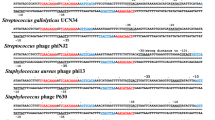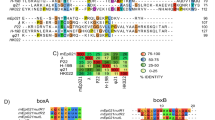Summary
Phage P22 mutationc27 defines a site required for establishment, but not maintenance of repressor synthesis. This study confirms that P22c27 is able to synthesize repressor if active repressor is present. An interaction involving gene products ofc1 andc3 and the sitec27 retards expression of the lytic genes of P22. Mutations in genec1 eliminate the retardation of lytic gene expression, butc27 does not alleviate the retardation. These results are used to construct a model that postulates that binding ofc1 andc3 products to DNA at or nearc27 is sufficient to cause retardation of lytic gene expression. The functioning ofc27 is contrasted to that of the analogouscy mutants of λ. The effect of thec27 mutation upon alleviation of “c1 repression” was studied in a partial revertant ofSalmonella typhimurium Pox-1 in whichc1 repression is exaggerated. The higher frequency of lysogenization seen in the mutant host is related to enhancedc1 repression.
Similar content being viewed by others
References
Adhya, S., Gottesman, M., de Crombrugghe, B.: Release of polarity inEscherichia coli by gene N of phage λ: Termination and antitermination of transcription. Proc. nat. Acad. Sci. (Wash.)71, 2534–2536 (1974)
Bezdêk, M., Soŝka, J.: The promotors and bidirectional transcription in theimm C region of P22 and L phages. Folia microbiol. (Praha)20, 206–211 (1975)
Bronson, M.J., Levine, M.: Virulent mutants of bacteriophage P22. II. Physiological analysis of P22vir B-3 and its component mutations. Virology47, 644–655 (1972)
Court, D., Green, L., Echols, H.: Positive and negative regulation by thecII andcIII gene products of bacteriophage λ. Virology63, 484–491 (1975)
Dopatka, H.D., Prell, H.H.: Amber mutants of Salmonella-phage P22 in genes engaged in the establishment of lysogeny. Molec. gen. Genet.120, 157–170 (1973)
Dottin, R.P., Cutler, L.S., Pearson, M.L.: Repression and autogenous stimulationin vitro by bacteriophage lambda repressor. Proc. nat. Acad. Sci. (Wash.)72, 804–808 (1975)
Echols, H., Green, L.: Establishment and maintenance of repression by bacteriophage λ. The role of thecI,cII, andcIII proteins. Proc. nat. Acad. Sci. (Wash.)68, 2190–2194 (1971)
Gough, M., Tokuno, S.: Further structural and functional analogies between the repressor regions of phages P22 and λ. Molec. gen. Genet.138, 71–79 (1975)
Honigman, A., Oppenheim, A., Oppenheim, A.B., Stevens, W.F.: A pleiotrophic regulatory mutation in λ bacteriophage. Molec. gen. Genetic.138, 85–111 (1975)
Jacob, F., Fuerst, C.R., Wollman, E.L.: Recherches sur les bacteries lysogenes defectives. II. Les types physiologiques lies aux mutations due prophage. Ann. Inst. Pasteur93, 724–753 (1957)
Levine, M.: Mutations in the temperate phage P22 and lysogeny inSalmonella. Virology3, 22–41 (1957)
Levine, M.: Replication and lysogeny with phage P22 inSalmonella typhimurium. Curr. Top. Microbiol. Immunol.58, 135–156 (1972)
Oppenheim, A., Honigman, A., Oppenheim, A.B.: Interference with phage lambdacro gene function by a colicin-tolerantEsherichia coli mutant. Virology61, 1–10 (1974)
Rao, R.N.: Bacteriophage P22 controlled exclusion inSalmonella typhimurium. J. molec. Biol.35, 607–622 (1968)
Reichardt, L., Kaiser, A.D.: Control of λ repressor synthesis. Proc. nat. Acad. Sci. (Wash.)68, 2185–2189 (1971)
Smith, H.O., Levine, M.: Two sequential repressions of DNA synthesis in the establishment of lysogeny by phage P22 and its mutants. Proc. nat. Acad. Sci. (Wash.)52, 356–363 (1964)
Spiegelman, W.G., Reichardt, L.F., Yaniv, M., Heinemann, S.F., Kaiser, A.D., Eisen, H.: Bidirectional transcription and the regulation of phage repressor synthesis. Proc. nat. Acad. Sci. (Wash.)69, 3156–3160 (1972)
Steinberg, B., Gough, M.: Altered DNA synthesis in a mutant ofSalmonella typhimurium that channels bacteriophage P22 toward lysogeny. J. Virol.16, 1154–1160 (1975)
Tokuno, S., Goldschmidt, E.P., Gough, M.: Mutant ofSalmonella typhimurium that channels infecting bacteriophage P22 toward lysogenization. J. Bact.119, 508–513 (1974)
Tokuno, S., Gough, M.: Host influence on the activity of genesc1 andc3 in regulating the decision between lysis and lysogeny in bacteriophage P22. J. Virol.16, 1184–1190 (1975)
Author information
Authors and Affiliations
Additional information
Communicated by G. Bertani
Rights and permissions
About this article
Cite this article
Tokuno, Si., Gough, M. Site c27 in phage P22 and control of the pathway to lysogeny. Molec. Gen. Genet. 144, 199–204 (1976). https://doi.org/10.1007/BF02428109
Received:
Issue Date:
DOI: https://doi.org/10.1007/BF02428109




